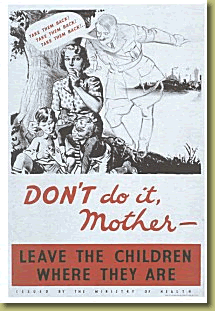Extraction from a
Source
(markscheme)
A member
of the public interviewed by Mass Observation said:
In
just one short walk I counted 48 official posters
... on hoardings, shelters, buildings, including
ones to tell you to eat National Wholemeal Bread,
not to waste food, to keep your children in the
country, to know where the rest centre is, how to
behave in an air raid shelter, to look out in the
black-out, to look out for poison gas, to carry your
gas mask always, to join the ATS, to fall in with
the fire bomb fighters, to register for Civil
Defence duties, to help build a plane, to recruit
for the Air Training Corps, to save for Victory.
What does Source D tell us about government propaganda
in Britain during the war?
The writer and broadcaster
JB Priestley wrote in his Postcripts (5 June 1940):
I wonder how many of you feel as I do
about this great Battle and evacuation of
Dunkirk.... When apparently all was lost, so much
was gloriously retrieved....
What strikes me about it is how typically English it
is.... And to my mind what was most
characteristically English about it was the part
played not by the warships but by the little
pleasure-steamers. We've known them and
laughed at them, these fussy little steamers, all
our lives. These 'Brighton Belles' and
'Brighton Queens' left that innocent foolish world
of theirs to sail into the inferno, to defy bombs,
shells, magnetic mines, torpedoes, machine-gun fire
- to rescue our soldiers.
How useful
is Source B to an historian studying propaganda in the
Second World War? Use Source B and your own knowledge to
answer the question.
A poster published
by the government in September 1939.

Why
was Source A published in September 1939?
Use Source A and your own knowledge to
answer the question.